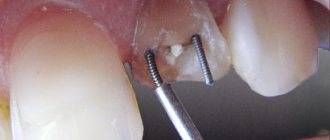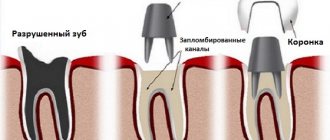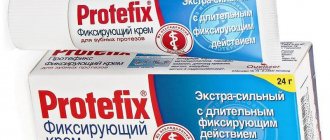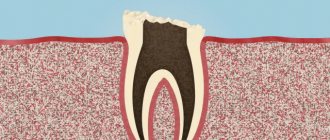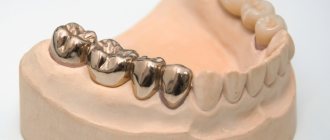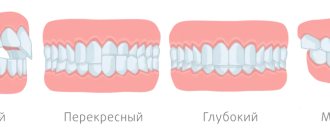June 15, 2019
Many patients are interested in the question of how to remove a crown from a tooth, because essentially the structure is permanent. However, this just means that the owner himself cannot remove it from the mouth, but the dentist, using tools and specialized equipment, will do this without difficulty. Today you will learn about how this process goes, by what methods the final result is achieved, what nuances await patients during the procedure of removing a crown from a tooth from an article prepared by journalists from the editorial office of the UltraSmile.ru portal.
What are the ways to remove a crown?
When is it necessary to remove a crown from a tooth?
Removing the crown from a tooth needs to be done only when there is a serious need for it, because the crown itself can be used for 7-10 years or more (the time period depends on the material from which the prosthesis was made).
Let us list the reasons why it is necessary to resort to such manipulation:
- a disease has developed under the structure: for example, secondary caries, periodontitis or a cyst,
- errors made at one of the stages of prosthetics: perhaps the crown does not correspond to the individual characteristics of the patient, is poorly installed and adjusted, is made of low-quality materials,
- the patient’s desire to replace the structure with a prosthesis made of a better and more beautiful material: for example, replace a metal or metal-plastic product with metal ceramics or zirconium dioxide,
- injuries that led to damage and breakage of an artificial tooth,
- destruction of permanent cement on which the orthopedic structure was fixed,
- The product has expired.
The reason for removal may be the development of caries under the crown.
If the tooth under the crown hurts, there is a bad smell, and the structure has become shaky and movable, then it is time to visit a dentist, who, based on an examination and x-ray, will decide on the need to remove and replace the artificial material.
According to numerous studies, the need to prematurely remove crowns already in the first years of use in 40% of all cases arises due to the fact that poor-quality endodontic treatment and poor-quality sanitation of the oral cavity were performed before preparing for prosthetics.
All of the above reasons are a serious reason to think about removing the prosthetic structure. Naturally, first you need to go to an appointment with a dentist, who will explain how crowns are removed from teeth. And we will look at the methods that exist today.
Method No. 1: sawing with a boron
So, let's figure out whether it is possible to remove a crown with permanent cement.
The method of removal using boron is the oldest and by far the most unaesthetic. This means that after using this tool, the sawn artificial material will only have to be thrown into the trash bin, because it can no longer be used for its intended purpose, that is, it will no longer be possible to re-prosthetize a tooth with it.
The technique is simple, cheap and quite effective, but it must be used by a doctor who has a high level of professionalism, because the approach requires caution and precision. An inexperienced specialist may damage the tooth itself or the soft tissue around it during the dismantling process.
With this method, it will not be possible to reuse the crown
“We removed the crown from the tooth with a regular bur and simply sawed it in half. There’s nothing terrible, but when the material got very hot, the smell, I’ll tell you, was not very good, plus there were slightly painful and uncomfortable sensations, even despite the fact that I had been given anesthesia before this, and the tooth itself had been under the prosthesis for a long time depulped!"
Mari, review from 32top.ru
This method is used if the patient has dentures made of inexpensive materials, which he would not mind disposing of later. The method is also suitable if the artificial structure itself is mobile or wobbly. Then it is simply sawed to the teeth, then, using special tools, the resulting edges are carefully bent in different directions and removed.
Free consultation on the cost of treatment in our dentistry
Leave a request and the clinic administrator will contact you within 15 minutes!
For single-rooted dental units, the depulpation process is mandatory, since the risks of thermal burns during grinding are quite high and this is fraught with the future development of an inflammatory process under the crown. Single-rooted teeth are drilled out, the nerve is removed, and the canals are cleaned and filled.
If there are dental diseases - caries, pulpitis, periodontitis - manipulations are performed to treat them. The nerves of the unit are removed, the canals are expanded with a special instrument, filled with gutta-percha, after which a filling is installed on the tooth itself. In case of serious damage to a tooth due to caries, it is important to install a strong filling and provide additional fixation. If this is not done, the dental crown may simply fall out along with a poor-quality filling. The process of restoration of a natural dental crown can be implemented in practice using two methods:
1. Installing a crown on a pin. The pin element is screwed into a pre-filled root canal and the natural coronal part of the tooth is restored at its base. After the filling is made, it is ground down to install the crown.
2. Using a stump insert. This element is manufactured in laboratory conditions and, when installed, is fixed in two areas at once: the dental canal and the area of the natural tooth crown.
These labor-intensive manipulations are carried out exclusively in the presence of serious destruction in the area of the natural dental crown, and if we compare the methods in terms of reliability, then the most high-quality result can be obtained by placing a stump inlay.
Method No. 2: using ultrasound
Are you wondering how to remove a crown from permanent cement in one of the safest and most innovative ways, and without causing any damage to it? Then ask your dentist if it is possible to use ultrasound in your case. Through impulses, the doctor acts on the cement composition, which gradually cracks. The specialist moves along the “tooth-crown” boundary; under the influence of vibrations, the cement is destroyed.
The product can be removed using ultrasound
The procedure really allows you to remove the structure in its original form, but it has a number of disadvantages. First, ultrasound has a rather gentle effect, so it is not always possible to achieve the goal the first time, and sometimes you have to visit the doctor several times. Secondly, only products that are made from not very dense materials are amenable to hardware exposure to sound waves. For example, it will not be possible to remove structures made using glass ionomers using ultrasound. Third, vibrations may be unpleasant for the patient.
Method No. 4: Kop (Koch) apparatus
This is a tool that again has a hook at the end. However, the device is not launched mechanically, but using a button, which breaks the cement along the edge of the crown using small shocks or a shock wave, after which the structure begins to move from its place. Next, the doctor can only use special forceps that hook and help to finally remove the prosthesis.
See what the Koch apparatus for removing crowns looks like in the photo.
This is what the Koch apparatus for removing crowns looks like
This device is more convenient and efficient than a manual device; it allows you to remove the product with virtually no damage and “works” quickly. However, it also has disadvantages. In particular, many patients note that during the procedures they feel “twitching” and discomfort. Also, some people are very concerned about the noise that the device makes. There is one more drawback - the device can damage the ceramic coating of the crown, leaving chips and cracks, and then the structure will have to be restored.
Types and benefits of dental implants
In modern dental clinics, high-quality implants from world manufacturers are used to restore the aesthetics and functionality of the dentition. All designs are divided into several groups.
Types of dental implants: description
, indications for installation:
1. Root-shaped - the most popular dental implants are cylindrical in shape with threads. The main design is a titanium pin. The implant takes root quickly, the risks of postoperative complications are the lowest. Installed when there is sufficient bone tissue.
2. Plate implants have a porous plate with a pin. Can be used if the bone tissue is too thin, when installation of a root-like structure is considered impossible. They are not designed for heavy loads, so they are mainly used to restore front teeth.
3. If there is a lack of bone tissue, subperiosteal implants, implanted into the space between the bone and the gum, are also effectively used. Recommended for installation after long-term absence of teeth.
4. Mini-implants are the optimal design for installation in patients who are contraindicated for full dental implantation. Such implants are used in single quantities and are not suitable for restoring a whole series.
On the dental implant market, global manufacturers present a wide variety of designs for restoring lost teeth, each with its own characteristics, advantages and disadvantages. Before carrying out a surgical procedure to implant an artificial tooth, it is very important to choose a high-quality implant with good performance characteristics and rapid healing.
Method No. 5: using the Coronaflex device
The device looks like a pistol, and its operating principle is based on compressed air, which escapes from the device under pressure and breaks the cement. At the same time, this device does not have any negative effect on the artificial material of the structure or on the soft tissues of the patient.
The Coronaflex device is not available in every dentist today, so the procedure with it will be more expensive compared to other methods. However, it makes sense to use the device if you have a zirconium dioxide crown, which can be reinstalled after, for example, the tooth under the structure is cured. In addition, the procedure using this device is more comfortable, safer, and requires less time to solve the problem. Also, according to patient reviews, the device makes virtually no noise, which allows you to feel comfortable in the dentist’s chair.
The Coronaflex device removes the crown quite comfortably
How long does it take for a wound to heal?
After surgery, the wound remains sensitive for 1-3 days. She needs special care for the next 2-3 weeks:
- upon returning home, apply ice or a cold compress to the intervention area;
- During the first hours you should not lie down, otherwise swelling may occur; it is better to sit or take a walk;
- You can only drink water at room temperature;
- Before the stitches are removed, you cannot eat flour, sticky foods, sweets, yoghurts; light soups, purees, and soft cutlets are allowed;
- in the first days, strong tea, coffee, and highly carbonated drinks are prohibited;
- You can chew only with the healthy side, rinse your mouth with warm water after each meal;
- one day after the operation, you can brush the adjacent teeth with a soft brush, but not with an electric brush or an irrigator.
Is it possible to remove a crown at home?
If you are interested in the question of how to remove a crown from a tooth at home, then the answer will be clear: you cannot do this at home. This procedure should only be performed by a professional dentist. For those who neglect this rule, everything can end sadly: there is a risk of damaging not only the artificial material, but also injuring the soft tissues and the tooth itself, which is located under the crown.
You can try to remove the structure yourself only if it has come unstuck and started to loosen, or if it has fallen apart or split, and there is a need to remove the remaining fragments of the product, which can injure the mucous membrane or antagonist teeth. But it’s better if you rush to see a dentist even in such situations.
If the structure comes unstuck, you can remove it yourself
If the materials from which the crown was created, as well as the cement, have expired, and you do not rush to the dentist, then an unpleasant situation may await you. For example, artificial material can be swallowed. What to do in such situations, read the material “5 useful tips for those who have swallowed a crown.”
How painful do patients experience swelling after the procedure?
When it comes to restoring a number of teeth, there is a high probability of postoperative swelling and pain. Both can be relieved by taking medications prescribed by a doctor and require adherence to a certain regimen. Firstly, it is better to stay in the dental clinic for some time after the operation. In specialized dentistry, a rest room is provided for these purposes. Secondly, you shouldn’t get behind the wheel right away - it’s better to call a taxi or drive home with someone close to you. Thirdly, for the first two weeks you should not play sports, carry heavy weights, visit a bathhouse or solarium, or drink alcohol or smoke.
Is it possible to cure a tooth without removing the crown?
The question is very relevant, because usually, after removing a structure, it can rarely be reused for its intended purpose, therefore, you have to pay money for the manufacture and installation of a new prosthesis. Fortunately, today in some cases you can do without removing the structure. For example, if it is necessary to cure recurrent caries or remove a small cyst, the doctor may perform endodontic manipulations through a small hole made in the crown or through an incision in the gum (to remove the cyst). After the procedures, this hole will be masked with a composite material, and the sutured gum will need time to heal.
In some cases, modern technologies make it possible to cure a tooth without removing the crown.
However, you need to understand that in order to safely and effectively carry out such jewelry manipulations, the doctor must be a professional. In addition, the patient himself should seek help when the problem is still minor and the inflammatory process has not gone too far. To do this, it is necessary to undergo preventive examinations, because the more minor the problem, the easier it is to solve it with therapeutic methods, without resorting to drastic measures.
Notice
: Undefined variable: post_id in
/home/c/ch75405/public_html/wp-content/themes/UltraSmile/single-item.php
on line
45 Notice
: Undefined variable: full in
/home/c/ch75405/public_html/wp-content /themes/UltraSmile/single-item.php
on line
46
Rate this article:
( 6 ratings, average: 5.00 out of 5)
crown
- Lutskaya I.K., Zinovenko O.G. Frequency of development of caries in teeth covered with artificial crowns.
Comments
Good afternoon. My metal-ceramic bridge on one tooth became movable. It is possible to remove the bridge without damage in order to reuse it. Thank you.
Svetlana (06/18/2019 at 11:25 am) Reply to comment
- Dear Svetlana! As a rule, no, the bridge is completely removed (you need to saw it). In addition, it is fixed on at least 2 supporting teeth, which apparently have become unusable.
Editorial staff of the portal UltraSmile.ru (06/21/2019 at 12:23 pm) Reply to comment
Tell me, how do you remove the crown from the implant?
AlinaR. (06/22/2019 at 17:29) Reply to comment
- Dear Alina! There are two extraction methods here, and which one to use will depend on how the crown is attached to the implant. If the fixation was screw (which is more preferable), then the doctor will simply unscrew the screws connecting the crown, implant and abutment. If the fixation was cement, then the specialist will use the cutting method - others are not suitable for implantation.
Editorial staff of the portal UltraSmile.ru (06/25/2019 at 09:19) Reply to comment
Which doctor should I go to to have my crown removed?
Makar (06/30/2019 at 10:02 pm) Reply to comment
- Dear Makar! This manipulation should be performed by an orthopedic dentist.
Editorial staff of the portal UltraSmile.ru (07/03/2019 at 09:17) Reply to comment
Is this procedure, removing a crown from a tooth, painful?
Arfa (07/18/2019 at 04:47 pm) Reply to comment
- Good afternoon This procedure cannot be called pleasant and comfortable, but it is painless, because... the doctor applies anesthesia. In addition, in most cases, crowns are used to replace already pulpless teeth that do not have a nerve. Pain and discomfort can only occur if inflammation has begun under the crown. Then pain can be felt not only in the tooth itself, but also in the soft tissues surrounding it.
Editorial staff of the portal UltraSmile.ru (07/26/2019 at 09:33) Reply to comment
Will my tooth hurt after the crown is removed?
Vedeneeva Victoria (05.08.2019 at 19:05) Reply to comment
- Dear Victoria. A tooth can only hurt if it has developed periodontitis or granuloma. Less often, pain occurs because the crown removal procedure was carried out by a not very professional doctor, who could injure the gums or mucous membranes, or damage the tooth itself.
Editorial staff of the portal UltraSmile.ru (08.08.2019 at 09:25) Reply to comment
Tell me, what if the crowns do not fit tightly to the gums on the back side, where is the palate? is this normal? that is, the tricrowns on the right entered the cast gums; three crowns _and the other three on the back side I feel their edges with my tongue….
san (01/09/2021 at 04:13) Reply to comment
Write your comment Cancel reply
How to make the rehabilitation period easier
First of all, it is important to strictly follow the doctor’s recommendations. Do not put stress on the area where the operation was performed or consume irritating foods or drinks. You should also give up alcohol and smoking, and not play sports. Swelling is a common consequence of root grafting surgery. This is a normal reaction of the body. The main thing is to ensure that all negative feelings gradually subside. If the swelling does not go away or gets worse, pain or redness appears, this is a reason to visit a doctor as soon as possible.



